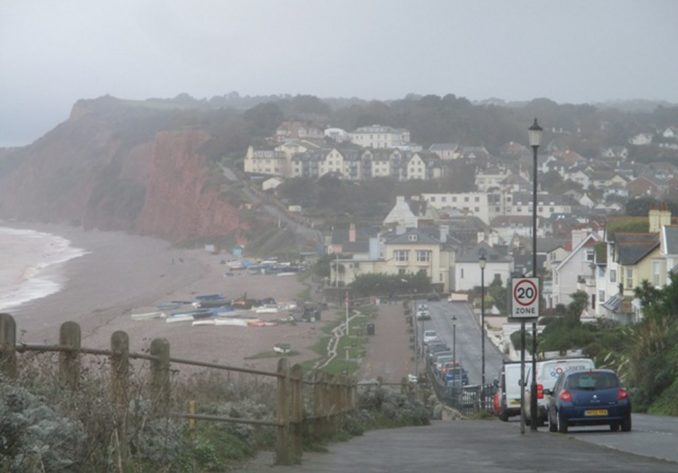
It takes a week to cycle from Penzance to Berwick. It took me 40 years. Because on the way, I wanted to include every town in England, in what amounted to some two years of day-rides. Most of these rides were point-to-point, but some were loops, and some looked on the map like a dropped noodle. It wasn’t a continuous line, but many separate lines, and all rides included towns I had not visited before. I used trains to get to starting points. Each ride had to be at least 20 miles, and in each new town, I had to touch a central feature, ideally the market cross or town hall. This is just one of hundreds of rides on this lifetime’s journey. A few more journey writeups can be found at my “Riding the Shires” website, from which this was taken, at Riding the Shires. Half a century of cycle-touring.
October 2023, Exmouth: Something was brewing in the Atlantic. This two-day autumn tour, the weather forecast had suggested, was likely to be a storm ride; I considered postponement. But everything was booked and the gale-force winds, as usual from the southwest, would be behind me. Heck, it could even be fun. So I set off, taking the train down from Yorkshire to the south Devon coast, and getting there at the refreshingly early time of half-eleven, thanks to a very early start and fortuitous connections.
On the train down, I shared the bike space with a geeky young man with bushy sideburns and an eye-catching £5,000 Gocycle electric. He had spent hundreds more on accessories: £150 for a single light, £40 on a mudguard, another £100 on pannier bags; and he rode with a video camera attached to the top of his helmet like a Prussian soldier’s Pickelhaube. It always amazed me how much some people are prepared to invest in the humdrum business of riding a bike. Yet he only used that ensemble for commuting a few miles to his job at a printing shop. My own leg-powered machine had cost less than a fifth of his, and my lights two pounds each. I had no mudguards or helmet at all. I don’t think he quite believed me when I said I was about to take on the storm-battered Jurassic Coast for nine hours.
As its name suggests, Exmouth lies at the mouth of the River Exe, somewhat south of Exeter. It bills itself as a resort these days, though it was long a dockyard town and retains a fair amount of terracing with brick-walled yards backing onto alleyways, a scene rarely found in the West Country. It had an interesting rather than lovely old centre, including a prominent building with an over 200-year-old shop frontage. Now evidently a private residence, this old drapers’ and early department store retained its arcades of arched display windows, infilled now with plain plate glass. Each arch of glass was the size of a broad doorway, vaguely evoking the coaching age. The evolution of shop-fronts in England closely tracked the development of glass-making technology, so that over several centuries windows expanded from casements to walls of glass. Large plate-glass windows, of the type we now think of as standard for shops, didn’t appear until late Victorian times. I don’t suppose this was the oldest original shop-front in the country, but it was the oldest I’d seen. The poster-dotted and glue-smeared panes concealed dark, dusty and empty space; it looked as though the last business there had recently gone belly-up.
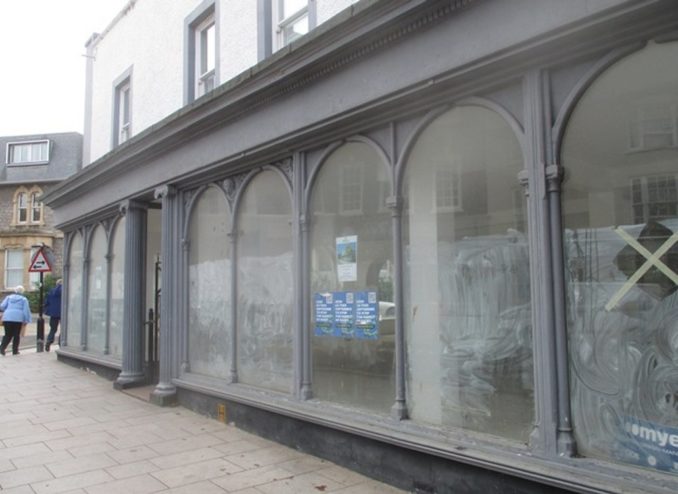
Exmouth has a reputedly good beach, looking across the estuary to the Dawlish area, but I didn’t have time for the waterfront and headed off to the remarkably named Phear Park to pick up the railway trackbed that would form the first stage of this ride, the old line to Budleigh Salterton. In the absence of signage, it took half-an-hour to track it down at the back of the park, which, by the way, is named for its donor, one Sir John Phear.
The branch line from Exmouth to Budleigh Salterton, both of which had separate connections to a West Country mainline, must have been one of the daftest railway projects in England. The terrain was difficult, and when it was built, the locals, even in the days before cars were universal, found little use for it; the demand was seasonal at best. It never managed to turn much of a profit or even offer a full timetable of services, and closed in 1967.
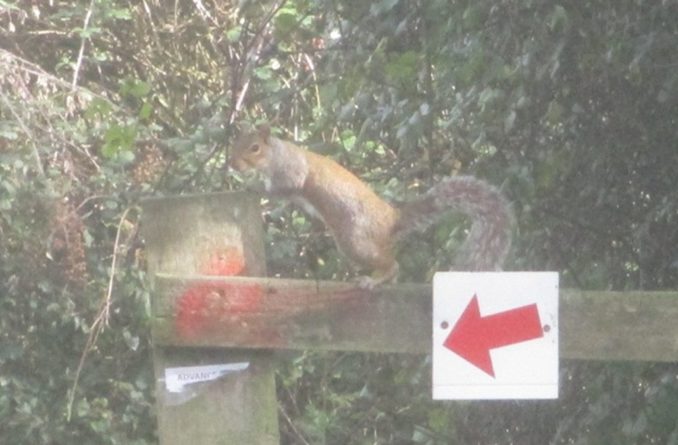
But I for one was pretty grateful for the folly of Victorian investors. Instead of slogging up and down steep coombe sides for six miles, I had a smooth, pleasant dawdle through turning woodland, crunching along a winding trail cushioned by a bed of acorns and beechmast and passing multitudes of squirrels darting about the bracken and gorging themselves on the fallen fruits of the forest. Ripe chestnuts clumped to the ground now and then, and a small river popped in and out of view, usually well below the trail, much of which rode a high bank. Budleigh Salterton came all too soon.
Here, the easy going ended for the day. At Budleigh, I hit the coast, with its rugged hills. This was a Victorian-genteel sort of place, little more than a posh seafront overlooking a litter of boats on the shore, all in the shadow of towering ochrous sandstone cliffs. It was the kind of resort favoured in the 1970s by my old West Country aunts. I briefly remembered them now: prim, kindly, comfortably-off ladies with an aversion to ITV as it ran common shows like Coronation Street. Budleigh Salterton looked about as far away from Coronation Street as you could get. With an art gallery, reiki and bridalwear salons, and shops with names like Reflections, you couldn’t get a coffee and snack here without shelling out a tenner. Sod that. I moved on unrefreshed.
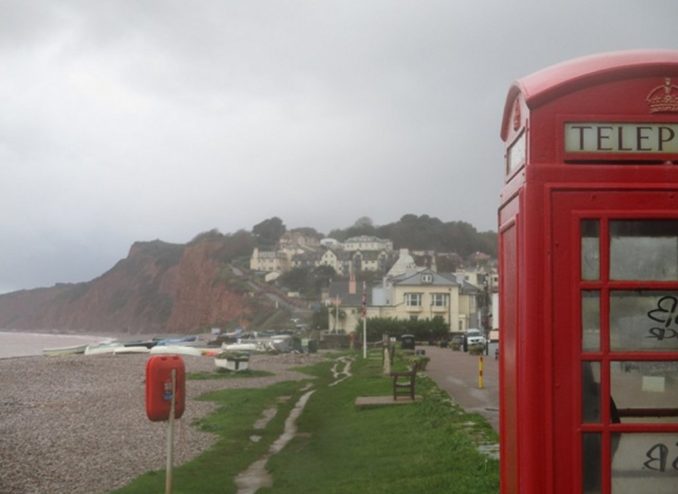
At the eastern end of Budleigh, I lucked upon a pleasant, high-hedged, winding back road along the west bank of the River Otter, which for some reason was closed to traffic. Littered with uncleared leaf-fall until it almost disappeared under its flakey russet carpet, this byway rose and dipped constantly as it tracked the levels alongside the Otter for some miles.
Leaving the Otter at Otterton, where the main street featured a long terrace of white cottages with moss-blotched grey thatches, the lanes lead through an empty, pastoral valley for a few more miles. I rode under sullen skies. To my surprise, there were a number of brick-and-flint cottages along the way. This was an occasional feature all along my route this day, though this wasn’t really their natural habitat, chalk country.
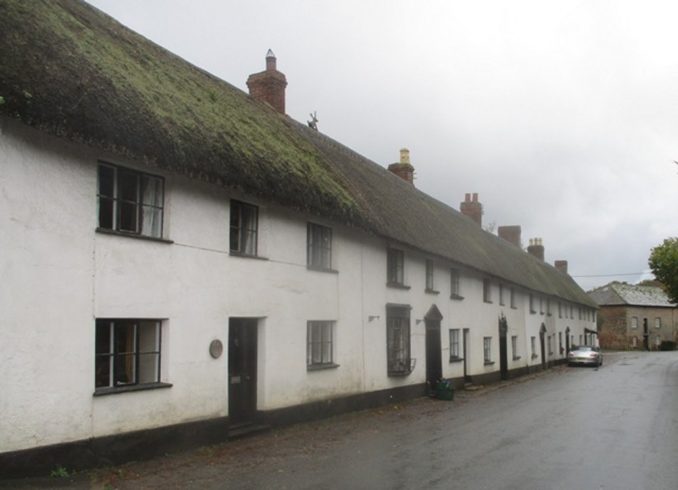
As I approached the coast again, the hard stuff began. And so did the rain. All along this coast, the land rears up and hurls itself down to the seashore in a ragged procession of mighty hills faced with sometimes fearsomely high cliffs. I climbed for half-an-hour through dripping oak woodland, breasted the summit and began the long freewheel down to the shore. The heavy wood cover frayed and parted, and through the ferny clearings I was astonished to see, far below to my left, the glory that is Sidmouth.
Sidmouth was a place I had, since my folkie days, associated with concertinas, shanties and bearded oafs with personalised tankards, but from this vantage point England’s premier trad-fest venue had a touch of the epic, with angry breakers pawing at its sands and huge brooding cliffs bookending the seafront of grand hotels and apartment blocks. In the poor light, cliffs, sands and sea all had the same dirty brown colour, seemingly of churned-up mud clawed from the seabed. I’ve enjoyed a lot of great views while cycling around England, but this was one of the most spectacular I could remember, and all the more so for its unexpectedness. Of this louring panorama I had an ever-shifting view as my road twisted its way down to the bottom.
By the time I reached the promenade, the rain had really set in and the wind was picking up too. I changed into waterproofs and lost half an hour in the backstreets among gurgling gullies and weirs trying to find the lane to Salcombe Regis. When I found it, I half-wished I’d used the longer main road route.

Sidmouth, above and below


As I’ve repeatedly moaned in other writeups, some of the worst hills in England aren’t in the Pennines or Cheviots, but along the West Country coasts, because, unlike the inland hills, they rise from sea level. So although their elevations on the map are far lower than Cross Fell or The Cheviot, the actual climbing effort is comparable. Getting up woody Salcombe hill took the best part of an hour. I was rewarded at the top with a rare ridge road, but the rain was worsening and daylight was now already fading, far earlier than I’d hoped. Once again, I hadn’t managed to keep up a good pace. Once again, the ride was turning into a race against night.
This puddle-streaked high road gently lowered me into increasingly rugged coastal hill country, in which high farms under wood edges looked out across narrow valleys. Of the few villages, the most beautiful by far was the straggle of whitewashed limestone cottages making up Branscombe, which lay loosely scattered down the side of a long chain of combes, its cottage profiles silhouetted in the glistening surface of the wet asphalt. As the day faded, the yellow lights from the hillside farms came on and shone like stars, seeming impossibly distant.
Leaving Branscombe, I was still dry inside, but by the next village, Beer, the wet had got through to both arms and legs. By now, it was almost dark and I’d already upset one motorist by stupidly riding without lights. I parked the bike by a bench in a pause in the rain to put the lights on. The more important back one was present and working, but not the front one. I burrowed about in my rucksack for fully ten minutes, pulling everything out and laying it out on the wet bench, before establishing that I’d left it on another bike, that backup number one didn’t work and that backup number two was also missing. I might have had more joy if I could have seen what I was doing, but, not having a light, ha-ha, I was searching mainly by groping. For a few minutes, I rather lost my rag on that bench in the woody cluster of steep lanes and charming cottages that is the back-end of Beer. They must have thought the local tramp had flipped his lid.
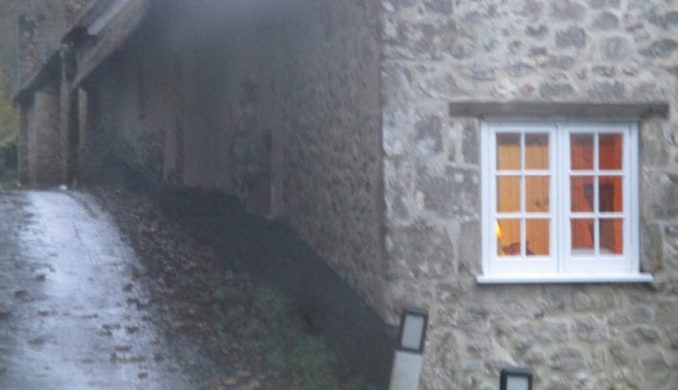
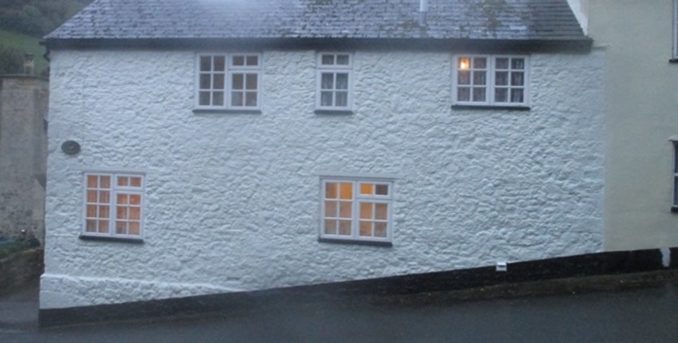
I couldn’t find it. But road riding without a front light in this weather was not on. I gingerly freewheeled down the pavement into Seaton, the next town on this challenging coast, where I hoped to buy a cheap torch. After 20 minutes of cruising about its bourgeois, bay-windowed streets, I drew a blank at all open outlets. What now?
In a pub, I sat down at the back dripping on the floor and commandeered an entire table for six. Covering it in plastic bags full of sopping junk, I went once more through the rucksack, item by item. That bloody spare light had to be there somewhere. A few people moved away and a few others started sneaking critical glances over their pints.
And lo, this time I found the missing backup, not in the rucksack stuff, but in a jacket breast pocket I’d forgotten I even had. One of those two-quid Chinese jobs I’d glibly shown to the Gocycle guy. I wasn’t so glib now. Praying it would work — not always a given with these Poundshop things — I switched it on. It did, but soon flickered.
I had a curious audience by this stage. Most of them sounded like Londoners, and residents rather than tourists. Or perhaps I should say refugees — the West Country is full of Londoners escaping London. One told me he was from Bedfordshire, and had bought a house in Beer.
“Lyme? You riding to Lyme? In this weather?”
“And you got a hell of a climb coming,” another gloated.
I pored over the map and pondered my options. I wasn’t confident the light would last the final two hours of this spin. But it was only about six o’clock — though it felt like eleven — and I could actually push it the eight miles to Lyme if the worst came to the worst.
So off I went, along the now very blowy seafront and then inland along the banks of the Axe. My cheap Chinese torch guttered and flickered at every bump, but never quite failed. It wasn’t designed for bike use, so I had to hold it between two fingers of my right hand like a cigar as I gripped the handlebars.
This road, the first flat going in hours, ended after a couple of miles, when I joined the A35 to Lyme. After Sidmouth and Salcombe’s huge hills, I wasn’t too worried about this threatened final “hell of a climb,” but the bloke in the pub wasn’t overstating things. Worse, the storm meant business now and it was pissing down — that kind of rain that has a real malevolence about it, a real desire to ruin your day. Soon I was pushing it uphill, ankle-deep in gutter overflow gushing down to the Axe valley. It was like walking against rapids. But I did at least have that ushering tailwind, howling in the trees beside the road and slapping curtains of rain into the back of my anorac. That was a lot better than getting it in the face.
About halfway up, my rucksack — unlike Gocycle man, I’d been too tight-fisted to buy a proper pannier bag — began falling off the pannier frame to which it was awkwardly attached. The first time, I swore lustily and righted it in a lay-by. The second time, preoccupied with the weather and the splashing from the lively stream of passing traffic, I didn’t notice it until it had slid halfway down the wheel and was fouling the spokes. It was just as well I was pushing, not riding. I fired off another volley of curses across the East Devon hills and righted it. But somehow, I just could not make it stay on the frame for long, no matter how I stretched or arranged the bungee cords.
The third time, I was hesitantly back in the saddle, near the top. The bungee cords got thoroughly snarled up with the spokes, dragging the rucksack off and almost toppling the bike. Now I couldn’t wrestle the rucksack free from the tangle of bungee cords, one of which had wound itself round the wheel hub. For five frenzied minutes, I squatted there in the pouring rain ranting and raving with a torch clutched between my teeth, trying to extricate the taloned bungee cords from the wheel hub and spokes. It’s hard to convey how fiddly this is when the cord has wound tight round the hub — if you’re a cyclist you’ll sympathise — but in the dark, I felt as helpless as a parachutist ensnared in a tree. Clearly, I couldn’t be accused of having over-invested in this ride.
No sooner had I sorted this out, and put the rucksack on my back (which of course I should have done in the first place), than a chilling sea mist swept in from the Channel, reducing visibility to a few hundred yards. The ride across the bare uplands was miserable, but, thanks to the wind, over fairly quickly.
I dropped down the long slope into the middle of Lyme, only to find the pub I was booked into was back up the hill on the edge of the town. It was nine o’clock in the evening before I was able to spread out my soggy maps and pull off my soaked clothes. After the shower, I unpacked for the third time and found I had no dry socks or shoes. Pillock. I knew there was a storm coming, and I’d forgotten to bring spare footwear. At least, though, I’d remembered the vodka. Boy, I needed that double-shot.
Looking at the map lying damply on the floor, I wondered if the river names Axe and Exe were originally the same word, and also the same word as Esk and Usk. So it turned out; all of them are Celtic in origin, as many English river names are, and the root word meant “water” and is probably also found in “whiskey.”
Despite the final dozen miles, I felt a lot better after a beer in the empty bar downstairs, for I was at a pub B&B, an old coaching house on a minor old highway away from the fashionable waterfront. It wasn’t oozing character, and I was too late for the kitchen, but I enjoyed half an hour’s banter with landlady’s daughter, who talked me through the wall photos of local social functions that they hosted.
“That one’s the rugby supporters getting boozed up, silly buggers. That one’s the meat draw.”
“The what?”
“Oh, we have lotteries and the prize is a rump steak. And that’s our ‘yard of ale’ competition” — she pointed to a posthorn-like glass on the wall. “And we have an annual charity draw for the lifeboatmen. And a Sunday Funday function, when customers choose tunes to be played on an iPad.” How did that work? “The iPad is wired to the speakers. Everybody sings along.”
I went out to a late shop in town to get some bread and cheese. There’ll always be an England, I hummed as I walked. I doubted that now, but if the old place was to survive, it would surely be in unassuming pub-based provincial communities like this.
Though this was October 31, I saw no Halloween shenanigans — no skull makeup or plastic witch hats or costumes — anywhere in town. I had at least that to thank the weather for. In fact, it had stopped raining. Lyme seemed to have been evacuated. The empty pavements glistened and the wind raced around the chimneys and gables, which crow-stepped steeply down to the restless sea.
I woke in the night and made a manful effort to watch British television, but it was no good, I’ll never go back to that. I did stay for a while with an Millionaire rerun, but as usual came a cropper at about 1,000 pounds when Chris T. asked a question that began “In EastEnders, who was ..” I must be the only person in Britain who cannot name an EastEnders character. I haven’t watched a soap for over 40 years. (Part 2 to follow)
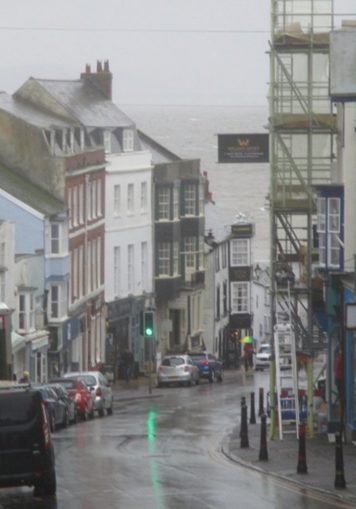
More like this can be found at my website Riding the Shires. Half a century of cycle-touring.
I’m fine with being quoted (up to two paragraphs), but all rights @joeslater.
© text & images Joe Slater 2025



